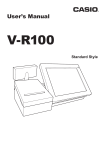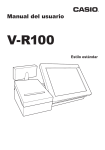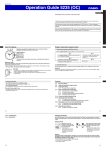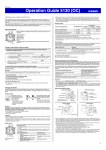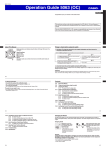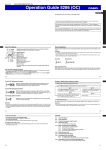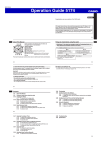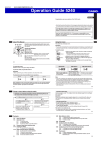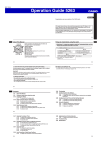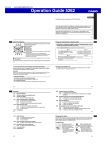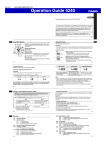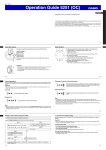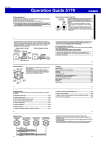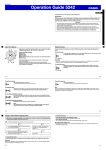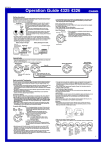Download Casio 5285 Watch User Manual
Transcript
Ú#!3)/#/-054%2#/,4$ MA1209-EC Operation Guide 5285 (OC) ENGLISH Congratulations upon your selection of this CASIO watch. x Note that the product illustrations in this manual are intended for reference only, and so the actual product may appear somewhat different than depicted by an illustration. This watch does not have a city code that corresponds to the UTC offset of –3.5 hours. Because of this, the radio-controlled atomic timekeeping function will not display the correct time for Newfoundland, Canada. Note that CASIO COMPUTER CO., LTD. assumes no responsibility for any damage or loss suffered by you or any third party arising through the use of this product or its malfunction. E-1 Crown Operations About This Manual > B @+* Operations are performed using the watch’s crown, and the three buttons indicated by the letters A, B and C in this manual. Hand Functions 5 6 z x c v b n m , . Hour Hand Second Hand Minute Hand Hour Hand (24-hour) Small Minute Hand Small Hour Hand Small Hour Hand (24-hour) Lower Dial Hand Day Indicator This User’s Guide uses numbers shown above to identify watch hands and indicators. Hand and Date Indicator Movement x The movement of the x Second Hand and c Minute Hand of this watch are coordinated. To change the c Minute Hand setting, you will need to move the x Second Hand. x . Day Indicator movement is also coordinated with z Hour Hand movement. To change the . Day Indicator setting, you will need to move the z Hour Hand. The crown can be pulled out to one of two (click) positions. Never apply undue force when pulling out the crown. Important! x In order to ensure full water resistance and to prevent damage due to impact, make sure that the crown is normally pushed in fully when using the watch. x When pulling out the crown, avoid using undue force, which creates the risk of personal injury to your fingers and fingernails, and of watch malfunction. First click Second click High-speed Movement When setting a time or when performing home position adjustment (page E-37), you can move the hands either forward or back at high speed. There are two high-speed levels: HS1 and HS2 (faster than HS1). E-3 E-2 To start HS1 high-speed movement While the crown is pulled out, rotate it rapidly three turns away from you (for forward movement) or towards you (for reverse movement). High-speed movement will continue even if you release the crown. Things to check before using the watch 1. Observe the movement of the x Second Hand. Is the x Second Hand moving smoothly at one-second intervals? NO To start HS2 high-speed movement Is the x Second Hand moving at two-second intervals or is it stopped completely? While HS1 high-speed movement is progress, again rotate the crown rapidly three turns in the same direction as the current HS1 movement (away from you for forward movement or towards you for reverse movement). YES Power is low. Charge the watch by placing it in a location where it is exposed to light. For details, see “Charging the Watch” (page E-9). To stop high-speed movement Rotate the crown in the direction that is opposite that of the current high-speed movement or press any button. YES The watch is charged. For details about charging, see “Charging the Watch” (page E-9). NEXT Go to step 2. 2. Check the Home City. Use the procedure under “To configure Home City settings” (page E-22) to configure your Home City. Important! x Leaving the crown pulled out for more than two minutes (approximately 30 minutes in the case of hand home position adjustment) without performing any operation will automatically cause crown operations to become disabled. If this happens, press the crown back in, pull it out, and then start the operation over again. Important! Proper time calibration signal reception depends on correct Home City, time, and date settings in the Dual Time Mode. Make sure you configure these settings correctly. E-4 3. Set the current time. x To set the time using a time calibration signal See “To get ready for a receive operation” (page E-15). x To set the time manually See “Configuring Current Time and Date Settings Manually” (page E-26). The watch is now ready for use. x For details about the watch’s radio controlled timekeeping feature, see “Radio Controlled Atomic Timekeeping” (page E-13). E-5 Contents E-2 About This Manual E-3 Crown Operations E-5 Things to check before using the watch E-9 Charging the Watch E-12 To recover from the sleep state E-13 Radio Controlled Atomic Timekeeping E-15 To get ready for a receive operation E-17 To perform manual receive E-18 To check the result of the latest receive operation E-18 To turn auto receive on and off E-20 Mode Reference Guide E-21 Timekeeping (Dual Time Mode) E-22 Configuring Home City Settings E-22 To configure Home City settings E-25 To switch between standard time and summer time manually E-26 Configuring Current Time and Date Settings Manually E-26 To change the current time and date setting manually E-30 Checking the Current Time in a Different Time Zone E-30 To view the time in another time zone E-6 E-7 Operation Guide 5285 (OC) E-32 To swap your Home City and World Time City Charging the Watch E-33 Using the Stopwatch E-33 To enter and exit the Stopwatch Mode E-33 To measure elapsed time E-34 To measure split times The face of the watch is a solar panel that generates power from light. The generated power charges a built-in rechargeable battery, which powers watch operations. The watch charges whenever it is exposed to light. Charging Guide E-35 Auto Start E-35 To set the Auto Start Time E-36 To start an Auto Start operation When wearing the watch, makes sure that its face is not blocked from light by the sleeve of your clothing. x The watch may enter a sleep state (page E-12) if its face is blocked by your sleeve even only partially. Whenever you are not wearing the watch, be sure to leave it in a location where it is exposed to light. x Best charging performance is achieved by exposing the watch to light that is as strong as possible. E-37 Adjusting Home Positions E-38 To adjust home positions E-40 Troubleshooting E-44 Specifications Warning! Leaving the watch in bright light for charging can cause it to become quite hot. Take care when handling the watch to avoid burn injury. The watch can become particularly hot when exposed to the following conditions for long periods. x On the dashboard of a car parked in direct sunlight x Too close to an incandescent lamp x Under direct sunlight E-8 E-9 Important! x Keep the watch in an area normally exposed to bright light when storing it for long periods. This helps to ensure that power does not run down. x Storing the watch for long periods in an area where there is no light or wearing it in such a way that it is blocked from exposure to light can cause power to run down. Make sure that the watch is exposed to bright light whenever possible. Power Levels B + @ Moves at two-second intervals. You can get an idea of the watch’s power level by observing the movement of the x Second Hand. x If the x Second Hand is moving normally at one-second intervals, power is at Level 1. x If the x Second Hand is moving at two-second intervals, power is at Level 2, which is quite low. Expose the watch to light as soon as possible so it can charge (Low battery alert). Level Hand Movement Function Status 1 Normal. All functions enabled 2 x Second Hand moves at two-second intervals. Time calibration signal reception and home position adjustment disabled 3 x Second Hand stopped. z Hour Hand and c Minute Hand stopped at 12 o’clock. . Day Indicator between 31 and 1. All functions disabled x When the watch is at Level 3, exposing it to light for a while will cause the x Second Hand to move to the position of second 57. This indicates that charging has started. Power Recovery Mode The watch is designed to go into a power recovery mode that stops hand operation temporarily whenever power suddenly drops below a certain level due to continuous signal reception or other operations over a short period. Note that all operations are disabled while the watch is in the power recovery mode. The hands will move to the correct positions and the watch will resume normal operation after power recovers (in about 15 minutes). Putting the watch in a location where it is exposed to light will help power to recover sooner. Charging Times Level Change *2 Exposure Level (Brightness) Level 3 Level 2 Level 1 Outdoor sunlight (50,000 lux) 8 minutes 2 hours Window sunlight (10,000 lux) 30 minutes 6 hours 89 hours Window sunlight on cloudy day (5,000 lux) 48 minutes 9 hours 144 hours 8 hours 97 hours ––– Indoor fluorescent lighting (500 lux) x When power drops to Level 3, all settings (including timekeeping) will be cleared. Recharging the battery will reset all settings to their initial factory defaults, so you will need to configure settings again. Daily Operation *1 24 hours * 1 Approximate exposure each day to generate power for normal daily operation. * 2 Approximate exposure to take power up one level. x The above times are for reference only. Actual times depend on lighting conditions. x For details about the operating time and daily operating conditions, see the “Power Supply” section of the Specifications (page E-44). E-10 E-11 Power Saving Radio Controlled Atomic Timekeeping Power Saving enters a sleep state automatically whenever the watch is left for a certain period in an area where it is dark. The table below shows how watch functions are affected by Power Saving. Elapsed Time in Dark Operation Approximately 1 week x All hands stopped at 12 o’clock x Internal timekeeping maintained This watch receives a time calibration signal and updates its time setting accordingly. However, when using the watch outside of areas covered by time calibration signals, you will have to adjust the settings manually as required. See “Configuring Current Time and Date Settings Manually” (page E-26) for more information. This section explains how the watch updates its time settings when the city code selected as the Home City is in Japan, North America, Europe, or China, and is one that supports time calibration signal reception. To recover from the sleep state Move the watch to a well-lit area or press any button. If your Home City Code setting is this: The watch can receive the signal from the transmitter located here: LONDON (LON), PARIS (PAR), ATHENS (ATH) Anthorn (England), Mainflingen (Germany) HONG KONG (HKG) Shangqiu City (China) TOKYO (TYO) Fukushima (Japan), Fukuoka/Saga (Japan) NEW YORK (NYC), CHICAGO (CHI), DENVER (DEN), LOS ANGELES (LAX), ANCHORAGE (ANC), HONOLULU (HNL) Fort Collins, Colorado (United States) Important! x The areas covered by HONOLULU (HNL) and ANCHORAGE (ANC) are quite far from the calibration signal transmitters, so certain conditions may cause reception problems. E-12 E-13 Approximate Reception Ranges UK and German Signals North American Signal Anthorn 2,000 miles (3,000 kilometers) 500 kilometers 600 miles (1,000 kilometers) 1,500 kilometers The Anthorn signal is receivable within this area. Fort Collins Mainflingen Japanese Signals Fukushima 500 kilometers Changchun Beijing Shangqiu Shanghai Chengdu Hong Kong Fukuoka/Saga 1,000 kilometers E-14 To get ready for a receive operation 1. Confirm that the watch is in the Dual Time Mode. If it isn’t, hold down C at least two seconds to enter the Dual Time Mode. Chinese Signal 500 kilometers x Signal reception may not be possible at the distances noted below during certain times of the year or day. Radio interference may also cause problems with reception. − Mainflingen (Germany) or Anthorn (England) transmitters: 500 kilometers (310 miles) − Fort Collins (United States) transmitter: 600 miles (1,000 kilometers) − Fukushima or Fukuoka/Saga (Japan) transmitters: 500 kilometers (310 miles) − Shangqiu (China) transmitter: 500 kilometers (310 miles) x As of June 2012, China does not use Daylight Saving Time (DST). If China does go to the Daylight Saving Time system in the future, some functions of this watch may no longer operate correctly for the China time zones. x Using this watch in a country covered by a time calibration signal that is different from the countries it supports may result in incorrect time indication due to local application of summer time, etc. 2. Place the watch in a location where signal reception is good. x Position the watch as shown in the nearby illustration, with 12 o’clock pointed towards a window. Make sure there are no metal objects nearby. 12 o’clock x Signal reception normally is better at night. x The receive operation takes from two to 10 minutes, but or in some cases it can take as long as 20 minutes. Take care that you do not perform any button operation or move the watch during this time. 1,500 kilometers E-15 Operation Guide 5285 (OC) x Signal reception may be difficult or even impossible under the conditions described below. To perform manual receive 1. Hold down C for at least two seconds to enter the Dual Time Mode (page E-21). 2. Hold down B for at least two seconds. x The x Second Hand will first indicate the last receive results as either Y (YES) or N (NO), and then move to R (Receive in progress) to indicate that signal reception has started. Inside or among buildings Inside a vehicle Near household appliances, office equipment, or a mobile phone Near a construction site, airport, or other sources of electrical noise Near hightension power lines 3. The watch’s time setting is adjusted automatically whenever a receive operation is successful. Among or behind mountains 3. What you should do next depends on whether you are using Auto Receive or Manual Receive. x Auto Receive: Leave the watch over night in the location you selected in step 2. See “Auto Receive” on page E-16 for details. x Manual Receive: Perform the operation under “To perform manual receive” on page E-17. @ Note x The current time indication may become out of sync by two or three minutes while a receive operation is in progress. Correct indication will resume after the receive operation is complete. If you need to produce a correct time reading immediately, press any button to stop the receive operation. x If reception fails for some reason, check the surrounding area and eliminate possible causes for failure and then try again. See “To get ready for a receive operation” (page E-15). Auto Receive x With Auto Receive, the watch performs the receive operation each day automatically up to six times (up to five times for the Chinese calibration signal) between the hours of midnight and 5 a.m. When any receive operation is successful, none of the other receive operations for that day are performed. x Calibration signal reception is disabled while the watch is in the Stopwatch Mode and an elapsed time measurement operation is in progress. x Calibration signal reception is disabled while the crown is pulled out. E-16 E-17 To check the result of the latest receive operation 1. Hold down C for at least two seconds to enter the Dual Time Mode (page @ E-21). 2. Press B. x The x Second Hand will move to Y (YES) if the latest receive operation was successful, or N (NO) if it was not. After about ten seconds, regular timekeeping will resume. x You can return to the Dual Time Mode manually by pressing B while the x Second Hand is pointing to Y (YES) or N (NO). Note x The x Second Hand will indicate N (NO) if you have adjusted the time or date setting manually since the latest receive operation. To turn auto receive on and off 1. Hold down C for at least two seconds to enter the Dual Time Mode (page Y (YES) @ E-21). 2. Press B. N (NO) E-18 4. Rotate the crown to move the x Second Hand to the setting you want. x To turn on auto receive, select Y (YES). x To turn off auto receive, select N (NO). 5. Push the crown back in to return to the Dual Time Mode. Radio-controlled Atomic Timekeeping Precautions x Strong electrostatic charge can result in the wrong time setting. x Even if a receive operation is successful, certain conditions can cause the time setting to be off by up to one second. x The watch is designed to update the date and day of the week automatically for the period from January 1, 2000 to December 31, 2099. Updating of the date by signal reception will no longer be performed starting from January 1, 2100. x If you are in an area where signal reception is not possible, the watch keeps time with the precision noted in “Specifications” (page E-44). x The receive operation is disabled under any of the following conditions. − While power is at Level 2 or Level 3 (page E-10) − While the watch is in the power recovery mode (page E-11) − While the watch is in the sleep state (power saving, page E-12) 3. During the 10 seconds that the x Second Hand is pointing to the latest receive operation result (see above), pull out the crown to the first click. x This will cause the x Second Hand to point to either Y (YES) or N (NO), which indicates the current on/off setting. x Leaving the crown pulled out for more than two minutes without performing any operation will automatically cause crown operations to become disabled. If this happens, press the crown back in, pull it out, and then start the operation over again. Mode Reference Guide Timekeeping (Dual Time Mode) To enter the Dual Time Mode, hold down C at least two seconds. Your watch has two “modes”. The mode you should select depends on what you want to do. To do this: Enter this mode: See: x View the current time in your Home City and in one of 29 other cities around the globe x View the current date in the Home City x Configure Home City and daylight saving time (DST) settings x Perform a time calibration signal receive operation x Configure World Time City and summer time settings x Swap the Home City and World Time City Dual Time Mode E-21 Use the stopwatch to measure elapsed time Stopwatch Mode E-33 C Dual Time Mode E-19 > B @+* Stopwatch Mode 5 6 x Pressing A causes the x Second Hand to move to the current Home City for about one second. x The . Day Indicator will change gradually between approximately 10 p.m. and 2 a.m. During this period the number indicating the day will not be centered in the indicator window. Indicates the day of the week (Su/Mo/Tu/We/Th/Fr/Sa). Indicates the 1/20 (0.05) second count. E-20 E-21 Configuring Home City Settings B + The Home City is location where you will normally use the watch. You can choose from a selection of city codes that represent 29 cities around the globe. x For information about specifying a World Time City, see “Checking the Current Time in a Different Time Zone” (page E-30). To configure Home City settings Note x This watch does not have a city code that corresponds to Newfoundland. @ E-22 Hand Functions z Hour Hand x Second Hand c Minute Hand v Hour Hand (24-hour) b Small Minute Hand: World Time minute hand n Small Hour Hand: World Time hour hand m Small Hour Hand (24-hour): World Time 24-hour hand , Lower Dial Hand: Indicates the current day of the week. . Day Indicator TOKYO (TYO) 1. Pull out the crown to the second click. x This will cause the x Second Hand to move to the city code of the currently selected Home City. x This indicates the city code setting mode. x Leaving the crown pulled out for more than two minutes without performing any operation will automatically cause crown operations to become disabled. If this happens, press the crown back in, pull it out, and then start the operation over again. x For details about city codes, see the “City Code Table” at the back of this manual. @ 2. Rotate the crown to move the x Second Hand to the city code you want to select as your Home City. x Each time you select a city code, the z Hour Hand, c Minute Hand and . Day Indicator move to the current time and date for that city code. x Whenever you move the x Second Hand to 12 o’clock while selecting a city code, it will automatically perform one full revolution and stop at 12 o’clock from the opposite direction. x The , Lower Dial Hand shows the summer time setting for the currently selected Home City. 3. Push the crown back in to return to the Dual Time Mode. E-23 Operation Guide 5285 (OC) STD/DST Switching You can select summer time or standard time independently for each city. The initial default setting for all cities is AUTO. Normally you should use the AUTO setting because it automatically switches between summer time and standard time. You should change the setting to STD (standard time) or DST (summer time) in the following cases. − When using the watch in a city not included in the City Code Table − When the switching dates in your location are different from those shown in the City Code Table To switch between standard time and summer time manually 1. Perform steps 1 and 2 under “To configure Home City settings” (page E-22). x Displaying the Home City Settings screen will cause the , Lower Dial Hand to move to AUTO (auto switching), STD (standard time), or DST (daylight saving time). Daylight Saving Time (DST) Daylight Saving Time (summer time) advances the time setting by one hour from Standard Time. Remember that not all countries or even local areas use Daylight Saving Time. x Note that you cannot switch between STD (standard time) and DST (daylight saving time) while UTC* is selected as your Home City. * Coordinated Universal Time, the world-wide scientific standard of timekeeping. The reference point for UTC is Greenwich, England. AUTO The watch automatically switches between standard time and daylight saving time in accordance with its calendar. STD The watch always shows standard time. DST The watch always shows daylight saving time. 2. Hold down A for about one second to cycle through the summer time settings as shown below. A AUTO A STD DST A 3. After the setting is way you want, push the crown back in. E-24 E-25 Configuring Current Time and Date Settings Manually C Home City/DST C Minute You can configure current time and date settings manually when the watch is unable to receive a time calibration signal. C Year To change the current time and date setting manually 1. Pull out the crown to the second click. x This will cause the x Second Hand to move to the city code of the currently selected Home City. x Leaving the crown pulled out for more than two minutes without performing any operation will automatically cause crown operations to become disabled. If this happens, press the crown back in, pull it out, and then start the operation over again. @ B 2. Change the Home City setting, if you want. x To change the Home City setting, perform step 2 under “To configure Home City Settings” (page E-22). TOKYO (TYO) @ 3. Hold down C for about one second. This will enter the time and date setting mode. x The x Second Hand will move to the 12 o’clock. x In the following steps, each press of C cycles between settings as shown below. Hour/Day C Month C 4. Rotate the crown to adjust the minute setting. x A high-speed movement feature (one full cycle maximum) is available when adjusting the hands. See “Crown Operations” (page E-3). 5. Press C. x The z Hour Hand will move slightly left and right to indicate the hour and day setting mode. 6. Rotate the crown to change the current hour and day settings. x Keep rotating the crown to move the z Hour Hand until the . Day Indicator shows the day you want. x The . Day Indicator will change gradually between 10 p.m. and 2 a.m. During this period the number indicating the day will not be centered in the indicator window. x While changing the hour setting, you can determine whether the setting is a.m. or p.m. by watching the . Day Indicator as the z Hour Hand passes 12 o’clock. x A high-speed movement feature (one full cycle maximum) is available when adjusting the hands. See “Crown Operations” (page E-3). E-26 E-27 Nov Dec Jan Oct Feb 0 7. Press C to enter the month setting mode. x The x Second Hand will move to the currently selected month. 1 9. Press C. This will enter the year setting mode. x The n Small Hour Hand will move to the number that represents the tens digit of the year and the b Small Minute Hand will move to the number that represents the ones digit. The x Second Hand will move to 12 o’clock and stop there. 2 8. Rotate the crown to adjust the month setting. * Sep Mar Aug Apr 9 3 8 Jul May @ Jun Setting the month 4 7 6 5 Setting the year (ones digit) 00 6 10 20 90 30 80 10. Rotate the crown to adjust the year setting. 11. After the settings are the way you want, push the crown back in to return to the Dual Time Mode. x This causes timekeeping to resume with the x Second Hand starting from 12 o’clock. x The day of the week indicated by the , Lower Dial Hand changes automatically in accordance with the date (year, month, and day). Note x The watch’s built-in full automatic calendar makes allowances for different month lengths and leap years. Once you set the date, there should be no reason to change it except after you have the watch’s rechargeable battery replaced or after power drops to Level 3. 40 70 50 60 Setting the year (tens digit) E-29 E-28 Checking the Current Time in a Different Time Zone You can specify one other city from the watch’s 29 time zones as your World Time City. After you do, the watch will indicate display the current time in that city. The currently selected city is called the “World Time City”. * Hands and Indicators The hands below indicate the current time in the World Time City. b Small Minute Hand n Small Hour Hand m Small Hour Hand (24-hour) 5 6 E-30 To view the time in another time zone 1. Pull out the crown to the first click. x The x Second Hand points to the currently selected World Time city code. x The , Lower Dial Hand will indicate AUTO, STD (standard time) or DST (daylight saving time), which indicates the current daylight saving time setting. x Leaving the crown pulled out for more than two minutes without performing any operation will automatically cause crown operations to become disabled. If this happens, press the crown back in, pull it out, and then start the operation over again. 2. Rotate the crown to move the x Second Hand to the city code you want to select as the World Time City. x Each time you select a city code, the b Small Minute Hand, n Small Hour Hand, and m Small Hour Hand (24-hour) move to the current time. For details about city codes, see the “City Code Table” at the back of this manual. x Whenever you move the x Second Hand to 12 o’clock while selecting a city code, it will automatically perform one full revolution and stop at 12 o’clock from the opposite direction. x If you think that the time indicated for the selected World Time City is not correct, it probably means that there is something wrong with your Home City settings. Use the procedure under “To configure Home City settings” (page E-22) to correct the Home City settings. 3. Hold down A for about one second to cycle through the summer time settings as shown below. x Selecting AUTO enables automatic switching between standard time and summer time. For details about the AUTO, STD and DST settings, see “STD/DST Switching” (page E-24). A AUTO A STD DST A 4. Push the crown back in. E-31 Operation Guide 5285 (OC) Swapping your Home City and World Time City You can use the procedure below to swap your Home City and World Time City. This capability can come in handy when you frequently travel between two locations in different time zones. Using the Stopwatch The stopwatch measures elapsed time and split times. The following example shows what happens when the Home City and World Time City are swapped while the Home City originally is TOKYO (TYO) and the World Time City is NEW YORK (NYC). @ Before swapping After swapping Home City World Time City TOKYO (TYO) 10:08 p.m. (Standard time) NEW YORK (NYC) 9:08 a.m. (Daylight saving time) NEW YORK (NYC) 9:08 a.m. (Daylight saving time) TOKYO (TYO) 10:08 p.m. (Standard time) To swap your Home City and World Time City Hold down A for about three seconds. x This will make the World Time City (NEW YORK in this example) your new Home City. At the same time, it will change your previous Home City to your new World Time City. x The x Second Hand will point to your new the Home City (NEW YORK in this example) for about one second. Note x If your current World Time City supports time calibration signal reception, making it your Home City enables calibration signal reception for that city. 6 Hand Functions b Small Minute Hand: Indicates the stopwatch seconds count. n Small Hour Hand: Indicates the stopwatch minute count (1 revolution = 60 minutes). m Small Hour Hand (24-hour): Indicates the stopwatch minute count (1 revolution = 120 minutes). , Lower Dial Hand: Indicates the 1/20 (0.05)-second count during stopwatch operation. To enter and exit the Stopwatch Mode In the Dual Time Mode, press C to enter the Stopwatch Mode. x The , Lower Dial Hand will move to 0. 5 * To measure elapsed time A A Start Stop B Reset x Pressing A to restart the stopwatch without resetting it will resume the elapsed time operation from where it was last stopped. E-32 E-33 To measure split times A B Start Split Auto Start Display of normal measurement returns after 5 seconds. A Stop B Reset Auto Start starts a countdown from a specified start time (Auto Start time), and automatically starts elapsed time measurement when the countdown reaches zero. x Pressing B again while a split time is indicated will cause the hands to jump to a new (current) split time. x Pressing A while a split time is indicated will stop the elapsed time operation, causing the hands to jump to the stop time. Note x The Stopwatch Mode can indicate elapsed time up to 1 hour, 59 minutes, 59.95 seconds. Elapsed time measurement will stop automatically when the maximum time is reached. x The display illustration on page E-33 shows a stopwatch reading of 20 minutes, 45.10 seconds. x Pressing B will not perform a reset operation while the hands are moving to elapsed timekeeping after you enter the Stopwatch Mode. x The , Lower Dial Hand indicates the 1/20 (0.05)-second count for the first 30 seconds of a stopwatch elapsed time operation. The x Second Hand will jump to the current value whenever A (Stop) is pressed. * 5 6 Hand Functions b Small Minute Hand: Auto Start seconds n Small Hour Hand: Auto Start minutes (0 to 60) m Small Minute Hand (24-hour): Auto Start minutes (0 to 119) To set the Auto Start Time x You can specify an Auto Start time within the range of 0 to 119 minutes and 59 seconds. 1. In the Stopwatch Mode, pull out the crown to the first click. 2. Rotate the crown to specify the Auto Start time seconds setting. x You can use high-speed movement (page E-3) when performing the above step. x Changing the seconds setting will also cause the minutes setting to change. 3. Press C. 4. Rotate the crown to specify the Auto Start time minutes setting. x You can use high-speed movement (page E-3) when performing the above step. 5. Push the crown back in. E-34 E-35 x If you do not perform any operation with the crown for about two minutes after pulling it out, crown operations will become disabled and the watch hands will no longer move when you rotate the crown. If this happens, push the crown back in and then pull it out again. To start an Auto Start operation 1. In the Stopwatch Mode with the elapsed time reset to all zeros, press B. x This causes the b Small Minute Hand, n Small Hour Hand, and m Small Hour Hand (24-hour) to move to the current Auto Start time. x Press B to toggle between the normal stopwatch screen and the Auto Start time screen. 2. While the Auto Start time is indicated by the hands, press A. x This starts the countdown from the Auto Start time. x For information about button operations after the Auto Start starts elapsed time measurement, see “To measure elapsed time” (page E-33) and “To measure split times” (page E-34). Note x To interrupt the countdown and immediately start the elapsed time operation, press A. x You can perform all normal stopwatch button operations after the elapsed time operation starts. x Auto Start is turned off automatically when you reset the stopwatch to all zeros after the current elapsed time operation. However, you can recall the last Auto Start time you set by pressing B. E-36 Strong magnetism or impact can cause the hands and/or day setting to be off, even if the watch is able to perform the signal receive operation. The watch automatically corrects for deviation of the x Second Hand, c Minute Hand, and z Hour Hand. You also can trigger hand position adjustment manually, if you want. x The v Hour Hand (24-hour) is adjusted simultaneously with the z Hour Hand. If you note that the position of the b Small Minute Hand, n Small Hour Hand, m Small Hour Hand (24hour), , Lower Dial Hand, or . Day Indicator is off, trigger home position adjustment manually. x The m Small Hour Hand (24-hour) is adjusted simultaneously with the n Small Hour Hand. Note x Any time after you enter the home position adjustment mode in step 1 of the following procedure, you can return to the Dual Time Mode by pushing the crown back in. In this case, any adjustments you made before the watch returned to the Dual Time Mode will be applied. x Leaving the crown pulled out for more than approximately 30 minutes without performing any operation will automatically cause crown operations to become disabled. If this happens, press the crown back in, pull it out, and then start the operation over again. x Pushing the crown back in will return to the Dual Time Mode, with any hand adjustments you have made up to that point in effect. E-37 To adjust home positions 1. Pull out the crown to the second click. B @+ B +* E-38 Adjusting Home Positions 2. Keep B depressed for more than five seconds. This will cause the x Second Hand to move to 12 o’clock. x Release B when the x Second Hand moves to 12 o’clock. This will start automatic correction of the x Second Hand, c Minute Hand, and z Hour Hand home positions. x Adjustment is complete when the x Second Hand, c Minute Hand, and z Hour Hand move to 12 o’clock. 3. Press C. x The z Hour Hand will start to move in order to advance the . Day Indicator. x Wait until the . Day Indicator stops between 31 and 1. 6. After confirming that the b Small Minute Hand is at the proper home position, press C. This will advance to n Small Hour Hand home position adjustment. x If the n Small Hour Hand moves to 12 o’clock, it is in the correct home position. If it doesn’t, rotate the crown to move it to 12 o’clock. x The m Small Hour Hand (24-hour) moves simultaneously with the n Small Hour Hand. If the hands are not at 12 o’clock, advance the n Small Hour Hand until they do. 7. After confirming that the n Small Hour Hand is at the proper home position, press C. This will advance to , Lower Dial Hand home position adjustment. x If the , Lower Dial Hand moves to 12 o’clock, it is in the correct home position. If it doesn’t, rotate the crown to move it to 12 o’clock. 8. Push the crown back in to return to the mode you entered from. x This will cause the hands to return to their normal positions and resume regular timekeeping. Wait until everything stops moving before performing any other operation. 4. If the . Day Indicator is not between 31 and 1, rotate the crown until it does. x Rotating the crown causes the z Hour Hand to move in 12-hour increments, and the . Day Indicator to move in half-day increments. 5. After confirming that the . Day Indicator is at the proper home position, press C. This will advance to b Small Minute Hand home position adjustment. x If the b Small Minute Hand moves to 12 o’clock, it is in the correct home position. If it doesn’t, rotate the crown to move it to 12 o’clock. 5 6 E-39 Operation Guide 5285 (OC) Troubleshooting Hand Movement and Position ■ I lost track of what mode the watch is in. Refer to “Mode Reference Guide” (page E-20). To return directly to the Dual Time Mode, hold down C for at least two seconds. ■ The x Second Hand is moving at two-second intervals. ■ All the watch’s hands are stopped at 12 o’clock and none of the buttons work (x Second Hand stopped at 57, 58, 59, or 00). Power may be low. Expose the watch to light until the x Second Hand starts moving normally, at onesecond intervals (page E-10). ■ The hands of the watch suddenly start moving at high speed, even when I do not perform any operation. This could be due to any one of the following causes. In all cases, the hand movement does not indicate malfunction, and should stop shortly. x The watch is recovering from a sleep state (page E-12). x The time setting is being adjusted following a successful auto time calibration signal receive operation (page E-13). ■ Hands suddenly stop moving. Button operation also is disabled. The watch may be in the power recovery mode (page E-11). Do not perform any operation until the hands return to their normal positions (in about 15 minutes). The hands should return to their correct positions when normal operation returns. To help power recover, leave the watch in a location where it is exposed to light. ■ The current time setting is off by hours. x Your Home City setting may be wrong. Check your Home City setting and correct it, if necessary (page E-22). ■ The current time setting is off by one hour. x If you are using the watch in an area where time calibration signal reception is possible, see “To configure Home City settings” (page E-22). x The period when summer time is applied in the location where you are using the watch may be different from the period set for your currently selected Home City. Use the procedure under “To switch between standard time and summer time manually” (page E-25) to switch from AUTO to STD (for standard time) or DST (for summer time). ■ The hands and/or day indications are off. This could indicate that the watch has been exposed to magnetism or strong impact, which has caused problems with proper hand and day alignment. Adjust the watch’s hand and day home position alignment (page E-37). ■ Data indication is correct, but it is not in the middle of the day indicator. The . Day Indicator will change gradually between approximately 10 p.m. and 2 a.m. each day. If the date is misaligned during this period, it is only momentarily and does not indicate malfunction. If you change your Home City setting while the current time in the new Home City is between approximately 10 p.m. and 2 a.m., the date may become misaligned momentarily. Charging ■ The watch does not resume operation after I expose it to light. It can take quite a long time to charge the battery after the power level drops to Level 3 (page E-10). Continue exposing the watch to light until the x Second Hand starts moving normally (at one-second intervals). ■ The x Second Hand starts to move at one-second intervals, but then suddenly returns to moving at two-second intervals. The watch probably is not sufficiently charged yet. Continue keeping it exposed to light. E-40 E-41 ■ The current time setting is off by one hour. Time Calibration Signal The information in this section applies only when LONDON (LON), PARIS (PAR), ATHENS (ATH), HONOLULU (HNL), ANCHORAGE (ANC), LOS ANGELES (LAX), DENVER (DEN), CHICAGO (CHI), NEW YORK (NYC), HONG KONG (HKG), or TOKYO (TYO) is selected as the Home City. You need to adjust the current time manually when any other city is selected as the Home City. ■ The x Second Hand indicates N (NO) when I check the result of the latest receive operation. Possible Cause Remedy Page x You are wearing or moving the watch, or performing a button operation during the signal receive operation. x The watch is in an area with poor reception conditions. Keep the watch in an area where reception conditions are good while the signal receive operation is being performed. E-15 You are in an area where signal reception is not possible for some reason. See “Approximate Reception Ranges”. E-14 The calibration signal is not being transmitted for some reason. x Check the website of the organization that maintains the time calibration signal in your area for information about its down times. x Try again later. — ■ The current time setting changes after I set it manually. You may have the watch configured for Auto Receive of the time calibration signal (page E-16), which will cause the time to be adjusted automatically according to your currently selected Home City. If this results in the wrong time setting, check your Home City setting and correct it, if necessary (page E-22). Possible Cause Remedy Page The period when summer time is applied in the location where you are using the watch may be different from the period set for your currently selected Home City. Use the procedure under “To switch between standard time and summer time manually” to switch from AUTO to STD (for standard time) or DST (for summer time). E-25 ■ Auto Receive is not performed or I cannot perform Manual Receive. Possible Cause Remedy Page Your Home City setting is wrong. Check your Home City setting and correct it, if necessary. E-13 E-22 There is not enough power for signal reception. Expose the watch to light to charge it. E-9 ■ Signal reception is being performed successfully, but the time and/or day is wrong. Possible Cause Remedy Page Your Home City setting is wrong. Check your Home City setting and correct it, if necessary. E-13 E-22 The watch may have been exposed to magnetism or strong impact, which has caused problems with proper hand and day alignment. Adjust the watch’s hand and day home positions. E-37 E-42 E-43 Specifications Accuracy at normal temperature: ±15 seconds a month (with no signal calibration) Timekeeping : Hour, minutes, seconds, 24-hour, day, day of the week Calendar system: Full Auto-calendar pre-programmed from the year 2000 to 2099 Other: Home City and World Time City can be assigned one of 29 city codes (29 time zones) and Coordinated Universal Time); Daylight Saving Time (summer time) auto switching/Standard Time Time Calibration Signal Reception: Auto receive up to six times a day (5 times a day for the Chinese calibration signal; Remaining auto receives cancelled as soon as one is successful); Manual receive Receivable Time Calibration Signals: Mainflingen, Germany (Call Sign: DCF77, Frequency: 77.5 kHz); Anthorn, England (Call Sign: MSF, Frequency: 60.0 kHz); Fukushima, Japan (Call Sign: JJY, Frequency: 40.0 kHz); Fukuoka/Saga, Japan (Call Sign: JJY, Frequency: 60.0 kHz); Fort Collins, Colorado, the United States (Call Sign: WWVB, Frequency: 60.0 kHz); Shangqiu City, Henan Province, China (Call Sign: BPC, Frequency: 68.5 kHz) Stopwatch: Measuring capacity: 1:59'59.95" Measuring unit: 1/20 (0.05) seconds Measuring modes: Elapsed time, Split time Other: Auto-Start Other: Power Saving; Low battery alert; Auto Correction of Hand Home Positions Power Supply: Solar panel and one rechargeable battery Approximate battery operating time: 5 months (from full charge to Level 3) under the following condition: 4 minutes of signal reception per day City Code Table L-1 E-44 City Code Table City Code City PAGO PAGO HONOLULU ANCHORAGE LOS ANGELES DENVER CHICAGO NEW YORK (PPG) (HNL) (ANC) (LAX) (DEN) (CHI) (NYC) Pago Pago Honolulu Anchorage Los Angeles Denver Chicago New York SANTIAGO (SCL) Santiago RIO Rio De Janeiro F. DE NORONHA (FEN) Fernando de Noronha PRAIA (RAI) Praia UTC London –2 –1 0 LONDON (LON) PARIS (PAR) Paris +1 ATHENS (ATH) Athens +2 JEDDAH (JED) Jeddah +3 TEHRAN (THR) Tehran +3.5 L-2 DUBAI KABUL KARACHI DELHI DHAKA YANGON BANGKOK HONG KONG TOKYO ADELAIDE SYDNEY NOUMEA (DXB) (KBL) (KHI) (DEL) (DAC) (RGN) (BKK) (HKG) (TYO) (ADL) (SYD) (NOU) Dubai Kabul Karachi Delhi Dhaka Yangon Bangkok Hong Kong Tokyo Adelaide Sydney Noumea UTC Offset/ GMT Differential +4 +4.5 +5 +5.5 +6 +6.5 +7 +8 +9 +9.5 +10 +11 WELLINGTON (WLG) Wellington +12 City Code Summer Time Period UTC Offset/ GMT Differential Summer Time Start Summer Time End –11 None None –10 –9 –8 2:00 a.m., second Sunday 2:00 a.m., first Sunday in –7 in March November –6 –5 Midnight, second Saturday Midnight, second Saturday –4 in October in March Midnight, third Sunday Midnight, third Sunday in –3 in February or Midnight, October fourth Sunday in February None None 1:00 a.m., last Sunday in March 2:00 a.m., last Sunday in March 3:00 a.m., last Sunday in March None Midnight, March 22 or Midnight, March 21 2:00 a.m., last Sunday in October 3:00 a.m., last Sunday in October 4:00 a.m., last Sunday in October None Midnight, September 22 or Midnight, September 21 City Summer Time Period Summer Time Start Summer Time End None None None None 2:00 a.m., first Sunday in October None 2:00 a.m., last Sunday in September 3:00 a.m., first Sunday in April None 3:00 a.m., first Sunday in April x Based on data as of June 2012. x The rules governing global times (UTC offset and GMT differential) and summer time are determined by each individual country. x The summer time periods in this table are applicable to specific cities. For cities not included in the list, select the list city that is in the same time zone as the desired city and perform STD/DST settings manually. L-3






